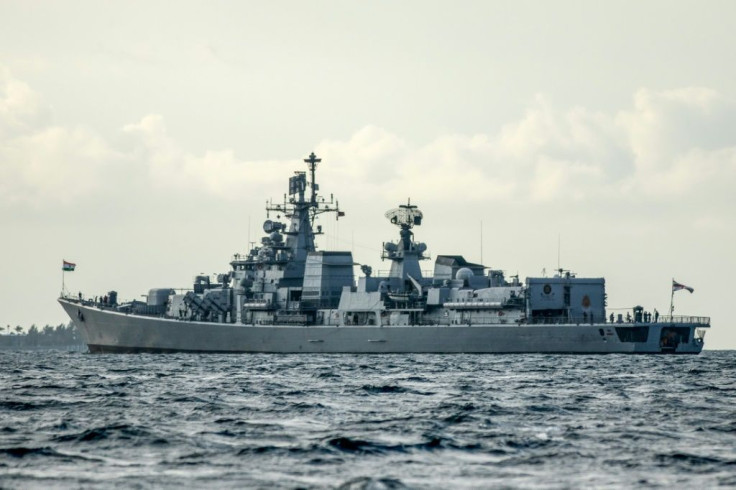A Ticket To Elite 'Blue Club': After Moon, India Eyes The Ocean Depths With Samudrayaan Mission

KEY POINTS
- Samudrayaan would be India's first manned ocean mission
- It plans to send three people to a depth of 6,000 meters in Indian Ocean
- The aim is to study deep-sea resources without disturbing the ocean ecosystem
After making a historic soft landing on the moon's south pole, India now aims for the ocean depths with the Samudrayaan mission, which could give the country a ticket to the "elite blue club" that includes nations like the U.S., France and China.
India is gearing up for its first manned ocean mission, which will send three people 6,000 meters (nearly 20 feet) deep in the Indian Ocean. The groundbreaking journey is to study deep-sea resources and conduct biodiversity assessments without affecting the vibrant ocean life.
India's Minister of Earth Sciences Kiren Rijiju shared images of the indigenously made manned submersible vehicle (MSV) MATSYA 6000, which will take the aquanauts to the ocean depths.
The project will not disturb the ocean ecosystem and will support Indian Prime Minister Narendra Modi's 'Blue Economy' vision, Rijiju said.
Next is "Samudrayaan"
— Kiren Rijiju (@KirenRijiju) September 11, 2023
This is 'MATSYA 6000' submersible under construction at National Institute of Ocean Technology at Chennai. India’s first manned Deep Ocean Mission ‘Samudrayaan’ plans to send 3 humans in 6-km ocean depth in a submersible, to study the deep sea resources and… pic.twitter.com/aHuR56esi7
"MATSYA 6000, in its maiden voyage underwater, will provide scientists with a unique opportunity to directly observe and study unexplored/uncharted deep-sea areas to open doors to scientific discovery and enhance the understanding of biodiversity," Alvarinho Luis, a senior scientist at National Centre for Polar and Ocean Research in India's Goa state, told International Business Times.
"Samudrayaan is a groundbreaking mission because there are only a few countries, which have the technological capabilities to reach the ocean floor at 6,000 meters below sea level," added Krishnendra Meena, the secretary general of the Society for Indian Ocean Studies in New Delhi.
"The vehicle is indigenously developed and built. The average depth of the Indian Ocean is less than 4,000 meters and this means that the deep-sea vehicle will potentially cover vast areas of the Indian Ocean floor," Meena told IBT.
After making strides in space exploration, India's deep ocean mission would provide entry to a small group of countries — the U.S., Russia, Japan, France and China — that have their own indigenous MSV. Moreover, deep ocean missions are expected to open up new avenues to leverage the maritime ecosystem without harming the marine environment.
Anisree Suresh, associate researcher at the nonprofit Centre for Public Policy Research (CPPR), said the Samudrayaan initiative would be "another feather in India's success cap" after the lunar expedition.
"This project aims to assist India in understanding and exploring deep sea areas through direct interventions, thereby increasing the economic potential of the blue economy, unlocking the potential of unexplored deep oceans for mineral resources, and developing deep-sea technologies for sustainable use of ocean resources," she said. "This initiative will get India to be part of the elite blue club of the select group of countries that are capable of deep-sea exploration."
Countries are advancing their efforts in ocean exploration because the deep sea is seen as a vast natural mine of resources that remains underutilized. If India's mission succeeds, it could use these resources to fuel its own economic needs and reduce its reliance on other countries.
"India has a vast Exclusive Economic Zone (EEZ) around its coastline, spreading over 2.2 million square kilometers (roughly 1.4 million square miles), and the deep sea here lies unutilized and unexplored," Meena said. "Mapping of the EEZ will be facilitated with Samudrayaan, which means better knowledge of the available resources (mineral and living)."
"Polymetallic nodules (PMNs) found on the deep ocean floor are rich in metals like copper, cobalt, nickel and manganese, which are essential for batteries in electric vehicles. PMN mining is a technological challenge considering the depth of occurrence of these nodules at four to six kilometers depth, adverse sea conditions and environmental challenges. Samudrayaan will allow India access to these nodules," he added.
India has exclusive rights to explore over 75,000 sq. km (nearly 47,000 miles) of area in international waters, allocated by the International Seabed Authority, for developmental activities and the extraction of metals from the polymetallic nodules.
"About 380 million tonnes of polymetallic nodules are estimated to be available, with 4.7 million tonnes of nickel, 4.29 million tonnes of copper, 0.55 million tonnes of cobalt and 92.59 million tonnes of manganese being the main metals present," Luis explained.
As land resources start to deplete, it is likely that big global powers ramp up their efforts to leverage other ecosystems like the space and ocean ecosystems to have larger stakes in available resources.
"India needs energy resources to run its economic wheel," Luis said. "Land resources are depleting and limited so the country is putting its human resources, scientific and technological capacities in the area of deep-sea exploration and development."
New discoveries made through deep ocean missions are also likely to lead to a higher demand for more research and innovation in the field. This could lead to the expansion of the blue economy and the addition of more players in deep-sea exploration.
"Such initiatives will create new economic opportunities for blue startups, ocean innovations, and maritime research, which will engage maritime communities and help the Indian economy grow," Suresh added. "It promotes fisheries and aquaculture, tourism, livelihoods and blue trade, as well as providing direct assistance to 30% of India's coastal population."
© Copyright IBTimes 2024. All rights reserved.





















